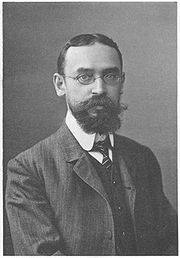
Hermann Johannes Pfannenstiel
Encyclopedia

Berlin
Berlin is the capital city of Germany and is one of the 16 states of Germany. With a population of 3.45 million people, Berlin is Germany's largest city. It is the second most populous city proper and the seventh most populous urban area in the European Union...
.
In 1885 he received his doctorate in Berlin
Berlin
Berlin is the capital city of Germany and is one of the 16 states of Germany. With a population of 3.45 million people, Berlin is Germany's largest city. It is the second most populous city proper and the seventh most populous urban area in the European Union...
and afterwards worked as a hospital assistant in Posen
Poznan
Poznań is a city on the Warta river in west-central Poland, with a population of 556,022 in June 2009. It is among the oldest cities in Poland, and was one of the most important centres in the early Polish state, whose first rulers were buried at Poznań's cathedral. It is sometimes claimed to be...
. Later he moved to Breslau, where in 1896 he became an associate professor. In 1902 he was appointed chairman of the department of obstetrics
Obstetrics
Obstetrics is the medical specialty dealing with the care of all women's reproductive tracts and their children during pregnancy , childbirth and the postnatal period...
and gynecology at the University of Giessen
University of Giessen
The University of Giessen is officially called the Justus Liebig University Giessen after its most famous faculty member, Justus von Liebig, the founder of modern agricultural chemistry and inventor of artificial fertiliser.-History:The University of Gießen is among the oldest institutions of...
, and five years later he became chair of the department of obstetrics and gynecology at the University of Kiel
University of Kiel
The University of Kiel is a university in the city of Kiel, Germany. It was founded in 1665 as the Academia Holsatorum Chiloniensis by Christian Albert, Duke of Holstein-Gottorp and has approximately 23,000 students today...
. From 1891 he was secretary of the German Society for Gynaecology (Deutsche Gesellschaft für Gynäkologie).
Among his better known publications were works on ovarian pathology
Pathology
Pathology is the precise study and diagnosis of disease. The word pathology is from Ancient Greek , pathos, "feeling, suffering"; and , -logia, "the study of". Pathologization, to pathologize, refers to the process of defining a condition or behavior as pathological, e.g. pathological gambling....
, uterine
Uterine
The word uterine can refer to different meanings:* relating to or near the uterus or womb* having the same mother, but different fathers, see matrilineality...
tumors and the formation of carcinoma
Carcinoma
Carcinoma is the medical term for the most common type of cancer occurring in humans. Put simply, a carcinoma is a cancer that begins in a tissue that lines the inner or outer surfaces of the body, and that generally arises from cells originating in the endodermal or ectodermal germ layer during...
s following ovariotomy. From 1896 he was co-editor of the Archives of Gynaecology (Archiv für Gynäkologie). In 1908 he was the first physician to give a comprehensive description of familial icterus gravis neonatorum.
Pfannenstiel is best remembered for the eponymous "Pfannenstiel's incision
Pfannenstiel incision
A Pfannenstiel incision is a type of surgical incision that allows access to the abdomen. Because the exposure is limited this incision should be used only when surgery is planned on the pelvic organs...
", which is a transverse incision used in genitourinary surgery
Surgery
Surgery is an ancient medical specialty that uses operative manual and instrumental techniques on a patient to investigate and/or treat a pathological condition such as disease or injury, or to help improve bodily function or appearance.An act of performing surgery may be called a surgical...
that is still widely used today. He published his paper in 1900 when he described 51 cases. His intent was to decrease the risk of an incisional hernia
Hernia
A hernia is the protrusion of an organ or the fascia of an organ through the wall of the cavity that normally contains it. A hiatal hernia occurs when the stomach protrudes into the mediastinum through the esophageal opening in the diaphragm....
; results also proved to be cosmetically better.
On July 3, 1909 at the age of 47, Pfannestiel died from septicemia after having injured his finger during surgery for an tubo-ovarian abscess.

